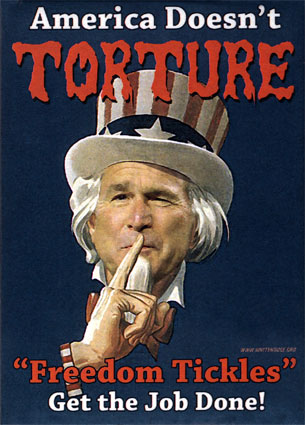George Bush's Torture: Taking Apart the President's Claims
 He’s back. He's unrepentant. He's proud.
He’s back. He's unrepentant. He's proud.
President George W. Bush, re-emerged into the media spotlight to plug his memoirs, has made headlines with his justification of waterboarding as an interrogation tool. “Damn right,” said Bush when asked to approve the waterboarding of Khalid Sheikh Mohammed, the planner of the 9-11 attacks. His argument, which the media has repeated with varying degrees of skepticism, is that it isn’t torture, it worked, and it saved lives.
Let’s take a look at these one at a time.
Is waterboarding torture? It has been considered as such in the past, including by the US. After World War II, for example, Japanese soldiers were punished, including some by execution, for their involvement in waterboarding Americans. Certainly, Christopher Hitchens, hardly an enemy of the Bush administration, believes it is torture after he underwent the procedure for a Vanity Fair article.
Did it work when used by the CIA? A full answer can’t be given because only certain individuals were privy to the information collected through waterboarding. Even if it did generate “actionable intelligence”, it is impossible to know whether what was obtained through waterboarding could also have been obtained through more conventional methods of interrogation.
However, we do have the testimony of at least one eyewitness privy to inside information. That person is Ali Soufan, an FBI interrogator involved in questioning al-Qaeda suspects, including Abu Zubaydah. He is on public record about enhanced interrogation methods versus traditional ones: “There was no actionable intelligence gained from using enhanced interrogation techniques on Abu Zubaydah that wasn’t, or couldn’t have been, gained from regular tactics.” He added that enhanced interrogation “backfired on more than a few occasions — all of which are still classified”.
Did waterboarding save lives? Bush's claim, and that of other supporters of torture, centres on the “revelations” of Khalid Sheikh Mohammed. At Guantanamo Bay in March 2007, Mohammed admitted to 31 separate plots, including having personally beheaded journalist Daniel Pearl. Among the aborted plots revealed were “plans to ‘destroy’ Heathrow Airport, Canary Wharf and Big Ben in London”.
Even taken at face value, Mohammed's confessions do not demonstrate that the exposed plots had moved from aspirational to operational. Indeed, members of the Blair Government in Britain, presumably having received details of these plots, were quick to distance themselves from Bush’s claims. Lord Goldsmith, the then Attorney-General, said, “I know President Bush has made these claims. I don’t know what evidence there is for it. I didn’t hear that at the time.” The former Director of Public Prosecutions added, “I’ve never seen anything to substantiate these claims. It’s an easy claim to make, it’s much more difficult to prove.”
It is not hard to make a counter-argument that, under repeated waterboardings, KSM admitted to almost every possible plot under the sun to stop the torture, to protect others, to boost his ego, or some combination of these.
But let’s accept that Bush’s argument is correct and follow it through to its logical conclusion. If waterboarding is not torture, is effective, and saved lives, then wasn’t the Bush administration negligent because it only used it on 3 individuals and not at all after 2003? Why didn’t it waterboard all al-Qaeda suspects, since who knows what secrets might have emerged? Why doesn’t it allow waterboarding against military prisoners in Afghanistan? Why not allow US police forces the right to waterboard domestic terrorism suspects?
The answer is, of course, obvious --- even to Bush, which is why he desperately seeks to justify the unjustifiable.

 Thursday, November 11, 2010 at 9:23
Thursday, November 11, 2010 at 9:23
Reader Comments